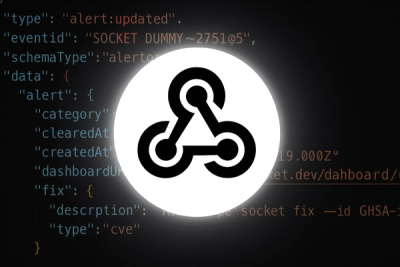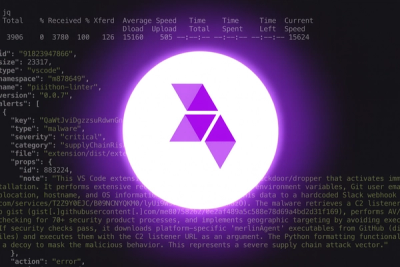
Product
Introducing Webhook Events for Alert Changes
Add real-time Socket webhook events to your workflows to automatically receive software supply chain alert changes in real time.
buildpg
Advanced tools
Query building for the postgresql prepared statements and asyncpg.
Lots of more powerful features, including full clause construction, multiple values, logic functions, query pretty-printing and different variable substitution - below is just a very quick summary. Please check the code and tests for examples.
Simple variable substitution:
from buildpg import render
render('select * from mytable where x=:foo and y=:bar', foo=123, bar='whatever')
>> 'select * from mytable where x=$1 and y=$2', [123, 'whatever']
Use of V to substitute constants:
from buildpg import V, render
render('select * from mytable where :col=:foo', col=V('x'), foo=456)
>> 'select * from mytable where x=$1', [456]
Complex logic:
from buildpg import V, funcs, render
where_logic = V('foo.bar') == 123
if spam_value:
where_logic &= V('foo.spam') <= spam_value
if exclude_cake:
where_logic &= funcs.not_(V('foo.cake').in_([1, 2, 3]))
render('select * from foo :where', where=where_logic)
>> 'select * from foo foo.bar = $1 AND foo.spam <= $2 AND not(foo.cake in $3)', [123, 123, ['x', 'y']]
Values usage:
from buildpg import Values, render
render('insert into the_table (:values__names) values :values', values=Values(a=123, b=456, c='hello'))
>> 'insert into the_table (a, b, c) values ($1, $2, $3)', [123, 456, 'hello']
As a wrapper around asyncpg:
import asyncio
from buildpg import asyncpg
async def main():
async with asyncpg.create_pool_b('postgres://postgres@localhost:5432/db') as pool:
await pool.fetchval_b('select spam from mytable where x=:foo and y=:bar', foo=123, bar='whatever')
>> 42
asyncio.run(main())
Both the pool and connections have *_b variants of all common query methods:
execute_bexecutemany_bfetch_bfetchval_bfetchrow_bcursor_b| Python operator/function | SQL operator |
|---|---|
& | AND |
| ` | ` |
= | = |
!= | != |
< | < |
<= | <= |
> | > |
>= | >= |
+ | + |
- | - |
* | * |
/ | / |
% | % |
** | ^ |
- | - |
~ | not(...) |
sqrt | ` |
abs | @ |
contains | @> |
contained_by | <@ |
overlap | && |
like | LIKE |
ilike | ILIKE |
cat | ` |
in_ | in |
from_ | from |
at_time_zone | AT TIME ZONE |
matches | @@ |
is_ | is |
is_not | is not |
for_ | for |
factorial | ! |
cast | :: |
asc | ASC |
desc | DESC |
comma | , |
on | ON |
as_ | AS |
nulls_first | NULLS FIRST |
nulls_last | NULLS LAST |
Usage:
from buildpg import V, S, render
def show(component):
sql, params = render(':c', c=component)
print(f'sql="{sql}" params={params}')
show(V('foobar').contains([1, 2, 3]))
#> sql="foobar @> $1" params=[[1, 2, 3]]
show(V('foobar') == 4)
#> sql="foobar = $1" params=[4]
show(~V('foobar'))
#> sql="not(foobar)" params=[]
show(S(625).sqrt())
#> sql="|/ $1" params=[625]
show(V('foo').is_not('true'))
#> sql="foo is not true" params=[]
| Python function | SQL function |
|---|---|
AND(*args) | <arg1> and <arg2> ... |
OR(*args) | <arg1> or <arg2> ... |
NOT(arg) | not(<arg>) |
comma_sep(*args) | <arg1>, <arg2>, ... |
count(expr) | count(expr) |
any(arg) | any(<arg1>) |
now() | now() |
cast(v, cast_type) | <v>::<cast_type> |
upper(string) | upper(<string>) |
lower(string) | lower(<string>) |
length(string) | length(<string>) |
left(string, n) | left(<string>, <n>) |
right(string, n) | right(<string>, <n>) |
extract(expr) | extract(<expr>) |
sqrt(n) | ` |
abs(n) | @<n> |
factorial(n) | !<n> |
position(substring, string) | position(<substring> in <st... |
substring(string, pattern, escape-None) | substring(<string> from <pa... |
to_tsvector(arg1, document-None) | to_tsvector(<arg1>) |
to_tsquery(arg1, text-None) | to_tsquery(<arg1>) |
Usage:
from buildpg import V, render, funcs
def show(component):
sql, params = render(':c', c=component)
print(f'sql="{sql}" params={params}')
show(funcs.AND(V('x') == 4, V('y') > 6))
#> sql="x = $1 AND y > $2" params=[4, 6]
show(funcs.position('foo', 'this has foo in it'))
#> sql="position($1 in $2)" params=['foo', 'this has foo in it']
FAQs
Query building for the postgresql prepared statements and asyncpg.
We found that buildpg demonstrated a healthy version release cadence and project activity because the last version was released less than a year ago. It has 1 open source maintainer collaborating on the project.
Did you know?

Socket for GitHub automatically highlights issues in each pull request and monitors the health of all your open source dependencies. Discover the contents of your packages and block harmful activity before you install or update your dependencies.

Product
Add real-time Socket webhook events to your workflows to automatically receive software supply chain alert changes in real time.

Security News
ENISA has become a CVE Program Root, giving the EU a central authority for coordinating vulnerability reporting, disclosure, and cross-border response.

Product
Socket now scans OpenVSX extensions, giving teams early detection of risky behaviors, hidden capabilities, and supply chain threats in developer tools.